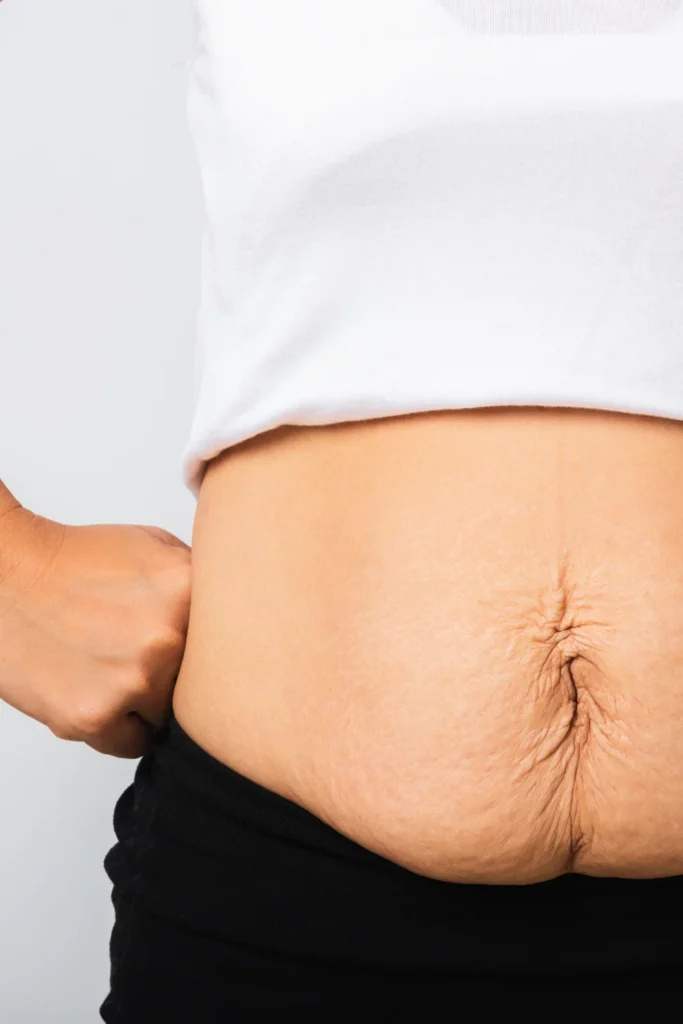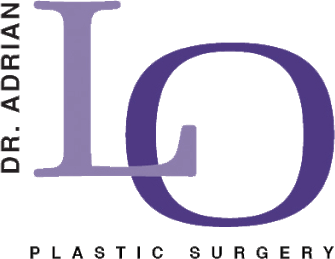Losing a substantial amount of weight is a significant achievement, but it often comes with an unexpected challenge: loose, sagging skin.
For many individuals, excess skin can feel just as difficult to manage as the weight they worked so hard to lose.
While this condition is common, it is not something you need to live with.
There are proven, professional solutions available — both surgical and non-surgical — that can improve skin firmness and restore confidence.
Understanding how to tighten loose skin after weight loss can help you choose between surgical and non-surgical options customized to help you reach your aesthetic goals.
Related: Do I Need a Tummy Tuck or Liposuction?
Why Loose Skin Develops After Significant Weight Loss

Weight gain stretches the skin, and when that weight is lost—especially in large amounts—the skin may not fully retract.
This issue often arises when skin elasticity has diminished due to long-term stretching. As collagen and elastin fibers weaken, the skin’s ability to recover its original form is reduced.
For many individuals, learning how to tighten loose skin after weight loss starts with evaluating skin quality, muscle tone, and health history.
Effects of Rapid Weight Loss on Skin Elasticity
Rapid weight loss gives the skin little opportunity to adjust.
When weight is lost quickly, such as through GLP-1s, crash dieting or bariatric surgery, the skin will become loose and form skin rolls or bulges.
Gradual weight loss tends to allow for more skin retraction, although this is not guaranteed.
Role of Age and Genetics in Skin Laxity
As individuals age, their skin naturally produces less collagen and elastin. These proteins are responsible for skin firmness and flexibility.
Additionally, genetic factors play a role in how resilient skin may be after weight loss. Some individuals may have naturally stronger collagen structures, while others experience more pronounced laxity.
Impact of Duration of Obesity on Skin Recovery
The length of time a person has carried excess weight directly impacts how much the skin stretches and how likely it is to retract.
Those who have been overweight or obese for many years often experience more severe skin laxity and may benefit most from surgical correction.
Skin Firming Through Nutrition and Hydration
A well-balanced, nutrient-rich diet supports overall skin health.
While nutrition alone cannot remove excess skin, it contributes to elasticity and collagen production.
Proper hydration helps maintain the skin’s fullness and flexibility, both of which are necessary for any skin-tightening efforts to succeed.
Exercise and hydration play a role in how to tighten loose skin after weight loss, especially when combined with consistent lifestyle habits.
Collagen-Boosting Foods to Support Skin Health
Foods rich in vitamin C, such as citrus fruits and bell peppers, help support natural collagen synthesis.
Zinc, found in lean meats and legumes, contributes to tissue repair.
Protein-rich foods, including fish, chicken, and eggs, supply the amino acids needed to build healthy skin structures.
Importance of Daily Water Intake for Skin Elasticity
Hydration enhances the skin’s texture and helps maintain its volume.
Dehydrated skin appears thinner and more fragile. Drinking sufficient water daily can help improve skin resilience and complement other treatment methods.
Vitamins That Promote Skin Regeneration
Vitamins A, C, and E are integral to skin repair. They contribute to cellular turnover, antioxidant protection, and hydration.
These vitamins can be obtained through diet or supplementation under medical supervision.
Targeted Strength Training to Support Skin Tightening

Building lean muscle mass beneath the skin can help create a firmer appearance, even if it does not directly eliminate excess skin.
Strength training fills out loose areas and enhances body contours, particularly in the arms, thighs, and abdomen.
Resistance Workouts to Build Muscle Volume
Exercises like deadlifts, leg presses, and chest presses target large muscle groups and contribute to overall body firmness.
Increasing resistance over time helps build muscle mass that supports and fills out the skin.
Compound Exercises for Arms, Legs, and Core
Movements that activate multiple muscle groups—such as squats, push-ups, and planks—are especially beneficial for shaping the body and improving posture.
When performed consistently, these exercises help tone the underlying structure that supports the skin.
Frequency and Consistency for Long-Term Results
Regular strength training, performed three to five times per week, is most effective in gradually changing muscle tone.
Over time, this consistency can reduce the appearance of sagging in specific areas, although it will not remove skin folds on its own.
Topical Treatments and At-Home Skin Firming Methods
While the effects of topical treatments are typically mild and temporary, they may improve the look and feel of skin when used regularly.
These methods are most effective when combined with professional treatments or used to maintain results.
If you are looking for non-surgical methods, there are limited but helpful ways in how to tighten loose skin after weight loss without undergoing surgery.
Retinoid Creams for Boosting Collagen
Retinoids, derived from vitamin A, promote dermal regeneration and can help thicken the skin over time. Prescription formulations are stronger than over-the-counter alternatives and are best used under medical guidance.
Firming Lotions with Hyaluronic Acid
Hyaluronic acid draws moisture into the skin, creating a temporary plumping effect that can reduce the appearance of fine lines and mild laxity.
These products offer short-term cosmetic improvement, particularly for the arms, neck, and decolletage.
Home Radiofrequency and Ultrasound Devices
Consumer-level devices that use heat or ultrasound to stimulate collagen are widely available. While convenient, their effects are significantly weaker than professional-grade technology and results vary between individuals.
Non-Surgical Skin Tightening Procedures
Non surgical skin tightening treatments are often used for patients with mild to moderate laxity who want to avoid downtime or anesthesia.
These treatments stimulate the body’s own collagen production without incisions or anesthesia.
Radiofrequency-Based Treatments
These devices use heat to target the dermal layer, triggering collagen remodeling and gradual skin tightening. Multiple sessions are usually required, and results appear over several months.
Ultrasound Skin Lifting Options
Ultrasound-based treatments such as Sofwave™, penetrate deeper into the skin to promote lifting and contouring. These are frequently used on facial areas but may also be suitable for the arms, abdomen and thighs.
For those researching how to firm sagging skin without surgery, options such as radiofrequency or ultrasound-based therapy may offer moderate results.
Laser Skin Tightening for the Abdomen and Arms
Laser therapy offers targeted heating that tightens the skin over time. Results can be subtle but visible, especially when paired with good skincare and healthy habits.
When to Consider Surgical Intervention for Loose Skin

Patients often explore how to tighten loose skin after weight loss with procedures that offer long-term improvement, especially when non-invasive methods may not be enough to achieve the desired result.
Skin tightening options after bariatric surgery or after significant weight loss, may include surgical and non-surgical interventions, depending on how much excess skin is present.
For individuals with significant excess skin that causes discomfort, limits movement, or affects hygiene, surgery may be the most effective and lasting solution.
When researching how to tighten loose skin after weight loss, it is important to understand which options are ideal for your specific skin condition and overall goals.
Candidacy Based on Skin Redundancy and Health
Candidacy is determined by the amount of excess skin, the patient’s overall health, and their goals.
Those experiencing chafing, rashes, or daily limitations due to redundant skin are often strong candidates for surgery.
Ideal Timing After Weight Stabilization
Patients should maintain a stable weight for at least six months before considering surgical treatment. This allows the body to adapt and ensures more predictable outcomes.
Managing Expectations for Recovery
Recovery from body contouring procedures requires rest, limited activity, and proper postoperative care. While results can be transformative, they take time to fully appear, and surgical incisions will be present, though often well-concealed.
Body Contouring Surgery Options
Body contouring after weight loss addresses areas where fat is still present or remains including the abdomen, arms, thighs, and back. Usually liposuction is the recommended treatment for body contouring after weight loss.
Loose skin surgery after weight loss offers a long-term solution for individuals dealing with redundant or excess skin that diet and exercise cannot resolve. The usual procedures to address the loose skin are tummy tuck, body lifts, arm lifts, thigh lifts and face lifts.
Plastic surgery for loose skin remains the gold standard for individuals with significant skin redundancy or loose skin following major weight loss.
Tummy Tuck (Abdominoplasty)
A tummy tuck for loose skin is often the most effective option for improving abdominal aesthetics after major weight loss.
A tummy tuck removes loose skin from the lower abdomen and tightens the underlying muscles. It is one of the most requested procedures after major weight loss and provides immediate improvement in abdominal contour.
Arm Lift (Brachioplasty)
This procedure addresses sagging skin between the elbow and underarm. It is especially popular among individuals who notice upper arm laxity following weight loss.
Thigh Lift for Inner Thighs
Thigh lifts remove excess skin and fat from the inner thighs, restoring proportion and improving comfort in fitted clothing.
Combining Procedures for Full-Body Results
The best procedures for excess skin depend on the location, severity of the laxity, and the patient’s desired outcome.
When multiple areas are affected, procedures may be combined in a single surgical plan or staged over time to achieve comprehensive results.
Lower Body Lift After Massive Weight Loss
This comprehensive procedure removes excess tissue from the abdomen, flanks, and buttocks in a single operation. It is commonly performed in patients who have experienced dramatic weight loss, such as after bariatric surgery.
Circumferential Tummy Tuck Techniques
Also known as a belt lipectomy, this technique addresses the entire midsection. It offers more complete contouring than a traditional tummy tuck by removing tissue around the entire torso.
Staged Surgery Plans for Safety and Outcome
When full-body contouring is needed, procedures are often performed in stages to reduce surgical time and improve healing. This plan prioritizes patient safety while achieving comprehensive results.
Preparing for Skin Removal Surgery
Preparation is vital for a successful outcome.
Patients must undergo medical evaluations, discontinue certain medications, and adjust their lifestyle to support optimal healing.
Pre-Surgical Lab Work and Medical Clearance
All patients must complete lab testing and obtain clearance from their primary care physician. This ensures that surgery is appropriate and the risk of complications is reduced.
Smoking Cessation and Skin Healing
Nicotine use compromises blood flow and impairs healing. All forms of nicotine must be stopped at least 2 weeks before surgery and 2 weeks after throughout the recovery period to reduce surgical risks.
Nutritional Planning for Post-Surgical Recovery
A diet rich in protein, vitamins, and minerals accelerates recovery and supports incision healing. Nutritional readiness plays a direct role in surgical outcomes.
Recovery and Aftercare Following Skin Tightening Procedures
Postoperative care involves managing swelling, monitoring healing, and following all guidelines provided by the plastic surgeon. Recovery times vary depending on the extent of surgery.
Compression Garments and Drains
Compression garments reduce swelling and support the new contours. Compression garments are worn for a minimum of 1 month and up to 6 months.
Drains are in place for approximately one week and are used to prevent fluid buildup and improve healing.
Activity Restrictions and Return to Work
Most patients return to non-strenuous work within two to four weeks, depending on the procedure. Heavy lifting and vigorous exercise should be avoided during the recovery period for 4 to 6 weeks..
Monitoring the Healing of Surgical Incisions
Regular follow-up appointments allow the plastic surgeon to evaluate incision healing and progress. Patients are advised to follow post-op instructions to minimize visible surgical scars.
Long-Term Maintenance of Skin Tightness
Maintaining results requires long-term lifestyle habits. Surgery addresses existing skin concerns, but it cannot prevent future laxity due to aging, weight changes or poor lifestyle habits.
Maintaining Stable Weight Post-Surgery
Weight fluctuations may stretch the skin again, reversing the benefits of surgery. Consistent weight management is essential for preserving surgical outcomes.
Ongoing Skin Hydration and Sun Protection
Daily moisturizing and the use of broad-spectrum sunscreen protects the skin’s elasticity and reduces the risk of hyperpigmentation near surgical incisions.
Importance of Protein Intake for Skin Support
A protein-rich diet supports skin cell repair and maintenance. It is especially important during healing and as part of a long-term skincare plan.
Risks and Considerations to Keep in Mind
All surgical and non-surgical procedures carry risks. These should be fully understood and discussed during the consultation process.
Potential for Surgical Complications
Although rare, complications such as bleeding, infection, or wound healing problems can occur. Selecting a qualified plastic surgeon significantly reduces these risks.
Limitations of Non-Surgical Options
Non-surgical treatments may offer only modest improvement. The non-surgical options are best suited for individuals with minimal laxity or for maintaining surgical results.
Understanding Individual Healing Variation
Every individual heals at a different rate. Factors such as age, skin type, and adherence to aftercare instructions influence the final outcome.
Ultimately, the choice of how to tighten loose skin after weight loss should be based on a consultation with a qualified plastic surgeon who understands post-weight loss anatomy.
Schedule a Personalized Skin Tightening Consultation with Dr. Adrian Lo
If loose skin is affecting your quality of life after weight loss, there are solutions available. Dr. Adrian Lo, a board-certified plastic surgeon serving patients in Pennsylvania, New Jersey, and Delaware, provides customized body contouring plans to help restore body aesthetics and confidence.
Contact us to begin planning your plastic surgery journey.
